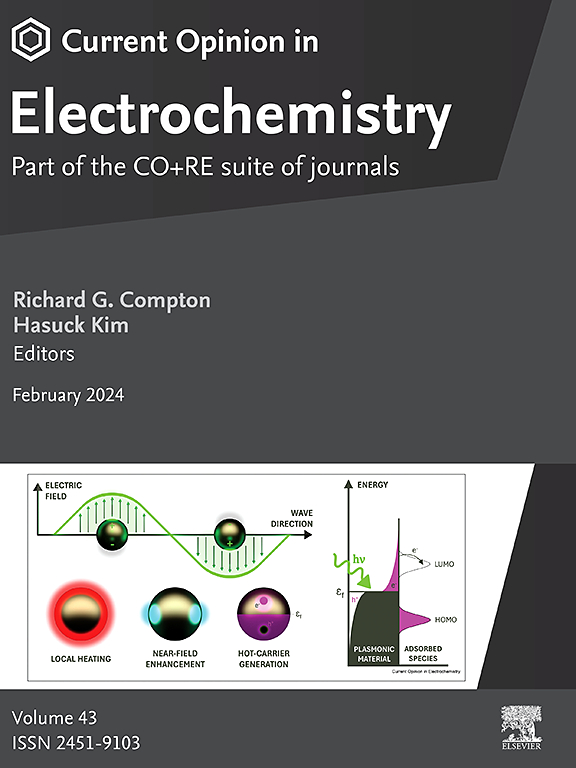电化学方法实时检测水和土壤中重金属的研究进展
IF 6.9
2区 化学
Q1 CHEMISTRY, PHYSICAL
引用次数: 0
摘要
重微量元素(HTEs),包括铅(Pb)、汞(Hg)、镉(Cd)和砷(as)等有毒金属,由于其在水和土壤系统中的持久性和生物积累,呈现出日益严重的环境和公共卫生问题。由于新兴技术对战略和稀土金属的需求增加,采矿、工业排放和农业等人为活动加剧了环境污染。传统的检测方法如(现场和在线)应用。本综述重点介绍了标准电化学技术的最新进展,特别是伏安法,如方波伏安法(SWV)、差分脉冲伏安法(DPV)和阳极溶出伏安法(ASV),以及非伏安法,包括电化学阻抗谱(EIS)和纳米材料增强的计时电位法,包括碳纳米材料:单壁碳纳米管(SWCNTs)和多壁碳纳米管(MWCNTs);金属及金属氧化物纳米颗粒;聚合物和杂化纳米复合材料;金属有机框架(MOFs)。这些材料提高了传感器的灵敏度、选择性、稳定性和标准电化学方法的可移植性,使其成为hte实时、原位和在线的理想选择。在这篇综述文章中,讨论了目前纳米材料和混合纳米复合材料在标准电化学技术方面的创新,改进了传感器的结构、功能化、灵敏度和选择性,以及性能指标和局限性。本文章由计算机程序翻译,如有差异,请以英文原文为准。
Recent trends in electrochemical methods for real-time detection of heavy metals in water and soil: A review
Heavy trace elements (HTEs), including toxic metals such as lead (Pb), mercury (Hg), cadmium (Cd), and arsenic (As), present a growing environmental and public health concern due to their persistence and bioaccumulation in water and soil systems. Driven by increased demand for strategic and rare earth metals in emerging technologies, anthropogenic activities such as mining, industrial discharge, and agriculture have intensified environmental contamination. Traditional detection methods such as (in situ and online) applications. This review highlights recent advances in standard electrochemical techniques, particularly voltammetric ones such as square wave voltammetry (SWV), differential pulse voltammetry (DPV), and anodic stripping voltammetry (ASV), in addition to being non-voltammetric including electrochemical impedance spectroscopy (EIS) and chronopotentiometry methods enhanced by nanomaterials, including carbon nanomaterials: single-walled carbon nanotubes (SWCNTs) and multiwalled carbon nanotubes (MWCNTs); metal and metal oxide nanoparticles; polymer and hybrid nanocomposites; and metal organic frameworks (MOFs). These materials improve sensor sensitivity, selectivity, stability, and portability of standard electrochemical methods, making them ideal for real-time and in situ and online for HTEs. In this review article, current innovations in standard electrochemical techniques with nanomaterials and hybrid nanocomposites improving sensor architecture, functionalization, sensitivity and selectivity are discussed alongside performance metrics and limitations.
求助全文
通过发布文献求助,成功后即可免费获取论文全文。
去求助
来源期刊

Current Opinion in Electrochemistry
Chemistry-Analytical Chemistry
CiteScore
14.00
自引率
5.90%
发文量
272
审稿时长
73 days
期刊介绍:
The development of the Current Opinion journals stemmed from the acknowledgment of the growing challenge for specialists to stay abreast of the expanding volume of information within their field. In Current Opinion in Electrochemistry, they help the reader by providing in a systematic manner:
1.The views of experts on current advances in electrochemistry in a clear and readable form.
2.Evaluations of the most interesting papers, annotated by experts, from the great wealth of original publications.
In the realm of electrochemistry, the subject is divided into 12 themed sections, with each section undergoing an annual review cycle:
• Bioelectrochemistry • Electrocatalysis • Electrochemical Materials and Engineering • Energy Storage: Batteries and Supercapacitors • Energy Transformation • Environmental Electrochemistry • Fundamental & Theoretical Electrochemistry • Innovative Methods in Electrochemistry • Organic & Molecular Electrochemistry • Physical & Nano-Electrochemistry • Sensors & Bio-sensors •
 求助内容:
求助内容: 应助结果提醒方式:
应助结果提醒方式:


